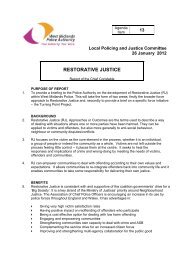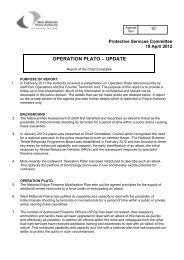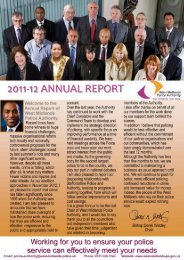NEIGHBOURHOOD POLICING - West Midlands Police and Crime ...
NEIGHBOURHOOD POLICING - West Midlands Police and Crime ...
NEIGHBOURHOOD POLICING - West Midlands Police and Crime ...
Create successful ePaper yourself
Turn your PDF publications into a flip-book with our unique Google optimized e-Paper software.
3COMMUNITY PRIORITY SETTING16. Community engagement <strong>and</strong> problem solving will remain at the heart of neighbourhoodactivity <strong>and</strong> is defined by the Continuous Improvement process to enable the NHTs tounderst<strong>and</strong> <strong>and</strong> meet the needs of the community by encouraging better planning,providing more targeted action <strong>and</strong> improving feedback to the community. The keyaspects to this are:Step 1: Engage17. WMP‟s neighbourhood policing model is based on the „bottom-up‟ principle that prioritiesshould be identified, scoped <strong>and</strong> agreed locally with the community. Therefore, the firststep in the process is to engage at a local level, gathering relevant issues <strong>and</strong> prioritiesfrom the local area, partner agencies <strong>and</strong> professional knowledge. This builds upon <strong>and</strong>formalises existing processes <strong>and</strong> the core aspects are summarised below. Moredetailed information about the tools, methods <strong>and</strong> options are available to Officers in theContinuous Improvement Creative Engagement Toolkit.Step 2: Establish the issues <strong>and</strong> set the priorities18. Visible neighbourhood policing alone will not deliver safe <strong>and</strong> satisfied communities.Instead, the key is to recognise <strong>and</strong> underst<strong>and</strong> that different communities requiredifferent forms of access <strong>and</strong> engagement from our Neighbourhood Teams.19. This is done by establishing the neighbourhood issues <strong>and</strong> setting priorities that needadditional internal or partner support to manage effectively.i) Underst<strong>and</strong>ing local concernsNeighbourhood officers should engage with the community to underst<strong>and</strong> localconcerns – this can be done in conjunction with partners.ii)iii)Establish the issuesAn issue is anything which can be managed locally as part of daily business, whichmay or may not require partner assistance. Issues requiring longer-term resolution(including CAPT support), should be escalated to the priority setting process.Set the prioritiesUsing the priority setting process, Neighbourhood officers can obtain widersupport. Each priority must have a SARA problem-solving plan <strong>and</strong> be recordedon CORVUS.Step 3: Plan20. Planning is central to the revised neighbourhood approach, ensuring robustmanagement <strong>and</strong> a means to measure progress against the agreed community priorities(<strong>and</strong> any issues deemed sufficiently important by the Neighbourhood Inspector). It alsoprovides the basis for community feedback <strong>and</strong> for ensuring resources are beingdeployed effectively <strong>and</strong> appropriately.Steps 4 <strong>and</strong> 5: Action <strong>and</strong> Evaluate21. Once a problem solving plan has been completed, NHT should ensure that actions <strong>and</strong>progress are monitored <strong>and</strong> completed operations evaluated appropriately. This willensure that the NHT resources are being used to best effect <strong>and</strong> will also help to informthe final step in underst<strong>and</strong>ing the community – resolution <strong>and</strong> feedback. Moreover, theforce will ultimately be held to account by the public for progress against problem solvingplans <strong>and</strong>, therefore, must provide a quality of service which enhances trust <strong>and</strong>confidence.Step 6: Resolve <strong>and</strong> feedback22. Feedback to the community is the final step in the revised approach. This is afundamental part of our strategy to keep the community informed of the actions beingtaken <strong>and</strong> ensuring that they remain confident their problems are being addressed. Allproblem solving plans must include feedback actions. A community priority will not beclosed until all actions have been undertaken <strong>and</strong> completed, including communityfeedback.
















